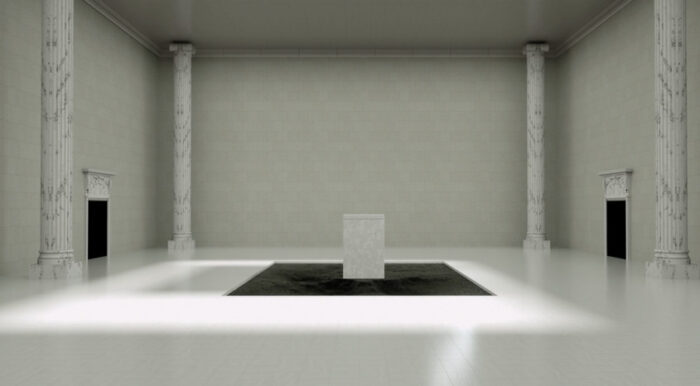
I’ve been thinking about the lives of deep-ocean crustaceans and octopuses: How do they go about their days when they don’t really have to work, or socialize even, given the scarcity of lives in the depth of the ocean? If they are just floating around all day, devouring a smaller fish or two, do they not get bored? With an unbeknownst destination, is life for them about a constant state of suspension in the vastness of the landscape, or rather, waterscape? While biology seems to have a simple answer for the meaning of life for us, namely, reproduction, humans are involved in the constant pursuit of self-fulfillment and willfully embark on a search for meaning, which, interestingly enough, oftentimes leaves us with more questions than answers.

In the group exhibition Offworlds, currently on view at YveYANG Gallery, 18 artists of Asian descent are brought together to contemplate the posthuman future, a possibly pan-global apocalypse, and the “aesthetics of failure.” Curated by Danni Shen, this exhibition at YveYANG Gallery presents the work of Shuyi Cao, Doreen Chan, Furen Dai, Dominique Fung, Antonia Kuo, Jia-Jen Lin, Ani Liu, Xin Liu, Xinyi Liu, Tan Mu, Goldie Poblador, Lau Wai, Augustina Wang, Anne Wu, Huidi Xiang, Rachel Youn, Lu Zhang, and Stella Zhong. Spanning three rooms and encompassing a wide range of media, the show emerges at a moment of prevalent existential crisis, when we have to think about how to coexist with artificial intelligence, given the possibility of future destruction and obsolescence.

The gallery space communicates a sense of emptiness. No lurid colors. Nothing overly flashy. Like how Goldie Poblador’s Single Hanging Cadena Vine (2023) is installed above eye level and requires the use of CFL lights for its true colors to shine through. The exhibits make sure to leave space for the contemplation of our proper erasure, “like a face drawn in sand at the edge of the sea.” For instance, On the Future Ruins (2022) by Furen Dai envisions a world in which museums are empty, reminiscent of Ilya and Emilia Kabakov’s 2004 installation, The Empty Museum. Shown alongside Untitled (2022) and Untitled (2023), which are empty apparatuses of display, the video questions whether “audiences can experience connections between cultures across time and space, methodologies of display without the art itself.” It makes me think about how we are stepping into an era of digital curating, when our own social media feeds are museums in a way, and we literally use the language of “photo galleries” to describe non-physical modes of memory preservation and presentation. Increasingly, the passing down of information becomes weightless. They say that the internet never forgets, but to completely lose touch with material artifacts might prove precarious as well.

In Huidi Xiang’s villa woodstock, a yellow chain hangs from the gallery’s non-functional industrial fan. It is a seemingly innocent play on Woodstock’s birdhouse from Charles M. Schulz’s comic strip Peanuts, but with a dark twist, as the bird’s head goes missing. Its resemblance to a canary once again reminds us of death—historically, in the coal mining industry, canaries, or their deaths, were used to detect carbon monoxide so that humans may survive. Snoopy’s eye visible through the birdhouse’s peephole foreshadows the abode’s imminent destruction. According to the artist’s interview with Al-Tiba9, the dystopian vision of innocent, escapist play is tied to the “habitual obligation of laboring. The game was no longer a world in which [the player] escaped from frustration. Instead, it engendered new forms of exhaustion.” Indeed, this installation touches on the unfeasibility of escapism. The toy-like façade of this sculpture is really a prelude to demise.

Erin E. Edwards’s 2018 book The Modernist Corpse insightfully pointed out the relationship between the posthumous and the posthuman. In Offworlds, figuration oscillates between life and death. From the memento mori in Augustina Wang’s paintings to the human fetuses in Ani Liu’s The Surrogacy (2022), the biomorphism of the body speaks to the vanishing or disillusionment of the human dimension. With the press release citing Déborah Danowski and Eduardo Viveiros de Castro, the show certainly has a political dimension related to decolonization and off-center myth-making. It prompts us to think about what the post-anthropocene might look like, drawing lessons from worlds that had already disappeared. Most importantly, I wonder if there is a way to leave the show without any feelings of nihilism. Perhaps the “clumsy” kinetics of Rachel Youn’s Pendulum, the material intimacy of Lu Zhang’s Losing Tolerance, New York, and the unconventional gravity of Stella Zhong’s Object of High Inertia 014 can get us excited about how unfamiliar a posthuman world would be—we, or our alternative manifestations, would have to learn to exist all anew.
I was talking to artist and publisher Jamie Martinez the other day, and he mentioned something that really stuck with me: A good exhibition doesn’t always blow your mind right away with some immediate, sensational impact. Instead, it generates a train of afterthoughts. Give it a day or two. Let it sink in. Offworlds is one of those exhibitions. Instead of casually tossing around words like posthumanism, post-posthumanism, or cyborgs, the display really materializes a spatial configuration that hinges on negation: a refusal to overstimulate, but also a refusal to forget. In the same room with anthropomorphic mechanical parts, pixelated landscapes, and illegible figures, the viewer is left wondering what the future holds. Should we lament the inescapable future where humans are no longer in control? Or should we appreciate the poetic beauty of uncanny objects wasting away in front of our eyes?
Offworlds is on view at YveYANG Gallery, New York, until December 2nd, 2023.
